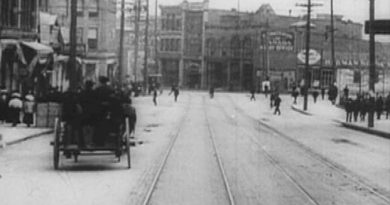Bluebird On Your Windowsill
Entertainment fans with long memories will recall that the first Canadian song to sell a million copies was written by a Vancouver nurse.
Her name was Carmen Elizabeth Clarke, and in 1947 she worked at what was then called the Hospital for Sick and Crippled Children, at 250 West 59th Avenue.
Jean Gould, the public relations director of the hospital when Elizabeth Clarke was there, remembered her well: “She was always interested in music and writing. I would say she was a real artiste. And she was very fond of the children. There was one little boy there who noticed a sparrow that kept hopping down onto the windowsill next to his bed. And she turned that conversation into a poem.”

Photo by Bert Katzung, 2003
There isn’t too much you can do in a song with a sparrow . . . and when Elizabeth Clarke sat down that rainy evening to write the poem out, she had the first line ready: “There’s a bluebird on your windowsill.” In six hours she had finished. She called the poem Bluebird on Your Windowsill and later set it to music.
A Province story by Les Wedman on November 7, 1949 quotes Mrs. Clarke as saying, “I didn’t intend to write it—it just came.” And she added that she still felt like crying whenever she heard it. She sang her song to her little patients—after it became a hit they called it “our song”—and friends and co-workers kept telling her the song was a good one, and so she eventually sang it on CKNW. “After requests began pouring in,” she told Wedman, “I got the idea the people really wanted it.” Empire Music in New Westminster published it in 1948 and, that same year, Aragon Records, a Vancouver company, made a records of the tune sung by Don Murphy.
Elizabeth Clarke paid to have that record made. That would be the last time she would have to do that. Slowly, steadily, surely, the song began to take off.
CKNW’s well-known Rhythm Pals (Mike, Marc and Jack) recorded it, and also claimed to have contributed something to the final published version. The Encyclopedia of Music in Canada says the claim is “unsubstantiated.” Several web sites show that Robert Mellin co-wrote the lyrics. I’ve been unable to find more details of that claim.
Elmer Tippe, of CKWX, remembered the Pals’ version of the song well. It was the big one locally. “Mike, Marc and Jack were a brand-new singing group at the time. Bluebird was being played constantly. It was on their 30th anniversary album issued in 1977.” Later, Wilf Carter recorded it, and then the song jumped the border and was recorded in the U.S. by Tex Williams.
So far, all of these versions were by country-and-western singers. When the song “crossed over” to the pop side in the US, it really began to break out. Wedman cited versions by Carmen Cavallaro, Freddy Martin, Ralph Flanagan, Charlie Kunz, the Andrews Sisters and several others. Then Doris Day recorded it, and so did Bing Crosby, and 38-year-old Elizabeth Clarke found herself the author of a monster hit.
In 1949 the March of Dimes chose Bluebird as the theme song for its 1950 national fund-raising campaign.
What makes this story particularly memorable is that Elizabeth Clarke donated every dollar she got for the song to children’s hospitals across Canada. It was an act of extraordinary generosity. The Children’s Hospital’s records for that period are buried somewhere in their archives, so it isn’t possible to say how much money was involved . . . but the various versions of the song topped a million copies (in a day when that was rare) and the sheet music brought in more. In 1985, the song was used in Sandy Wilson’s movie My American Cousin, and the Vancouver jazz group Mother of Pearl use the tune in their shows.
Newspaper stories show that Elizabeth Clarke wrote other songs, but none had the impact of that simple little tune inspired by the rainy-day visit of a sparrow to an ailing child.
In July, 1960, aged just 49, Elizabeth Clarke died in Altamont Private Hospital in West Vancouver.



![Vancouver Coat of Arms [Image: Wikipedia]](https://vancouverhistory.ca/wp-content/uploads/2021/01/1024px-Coat_of_arms_of_Vancouver.svg_-390x205.png)
